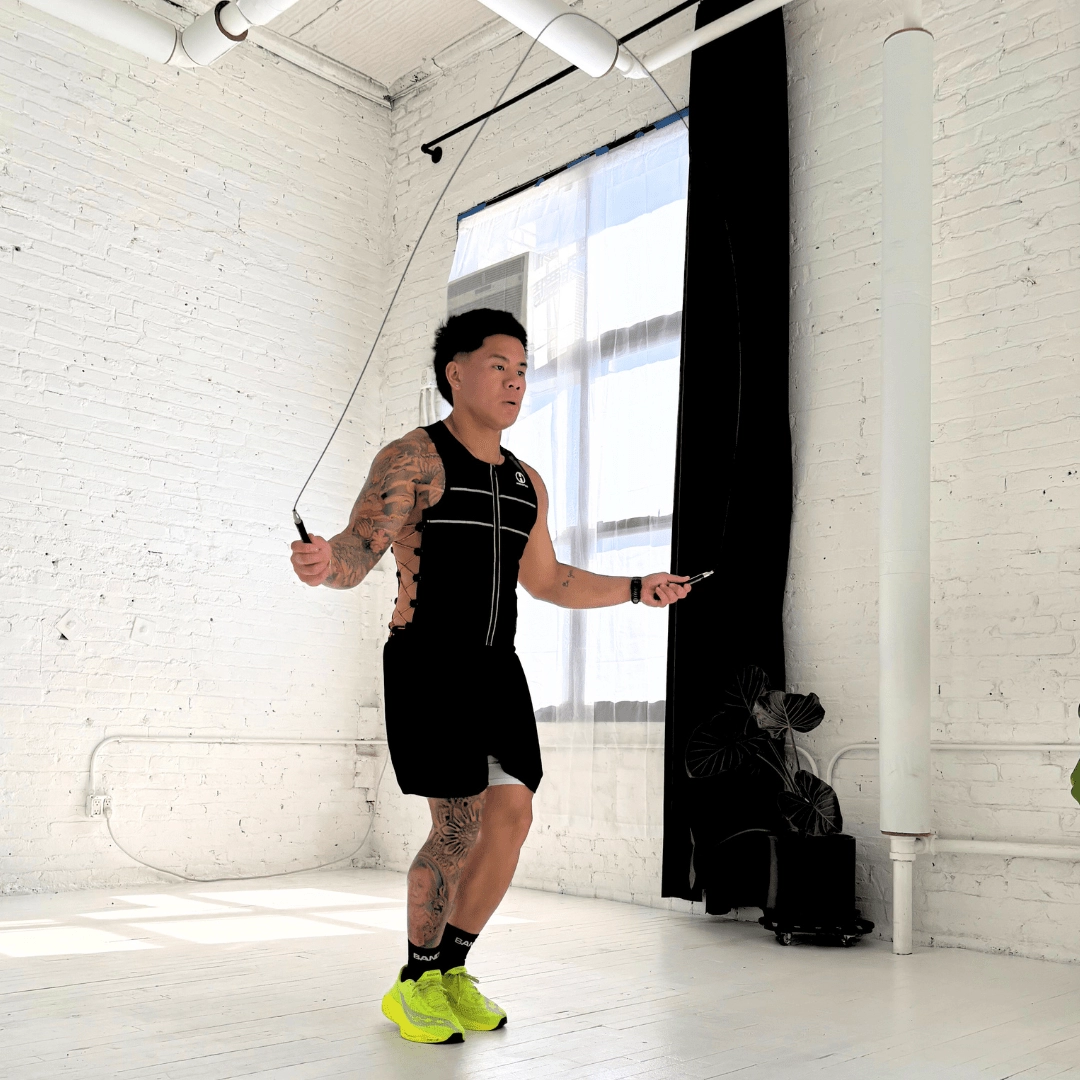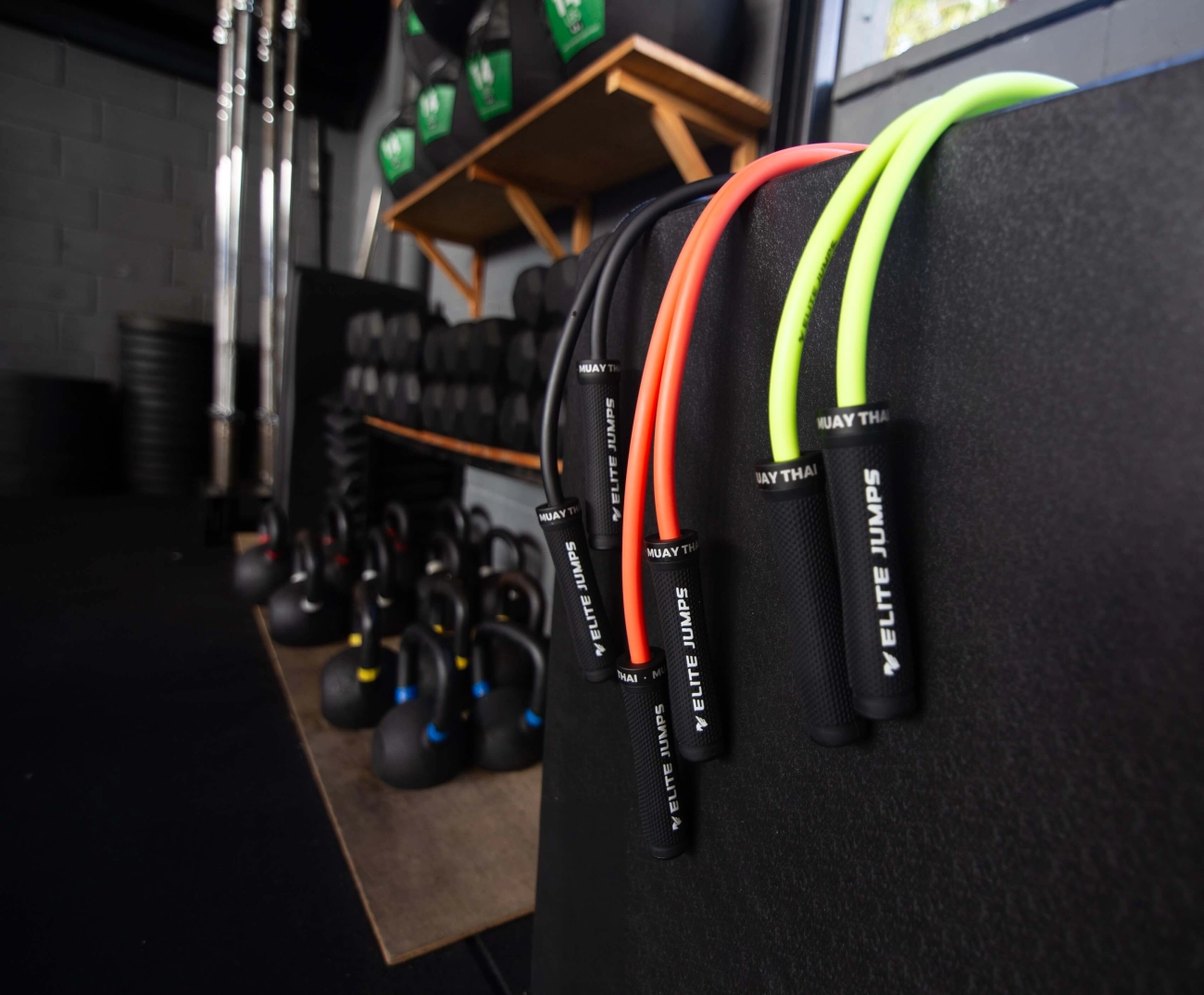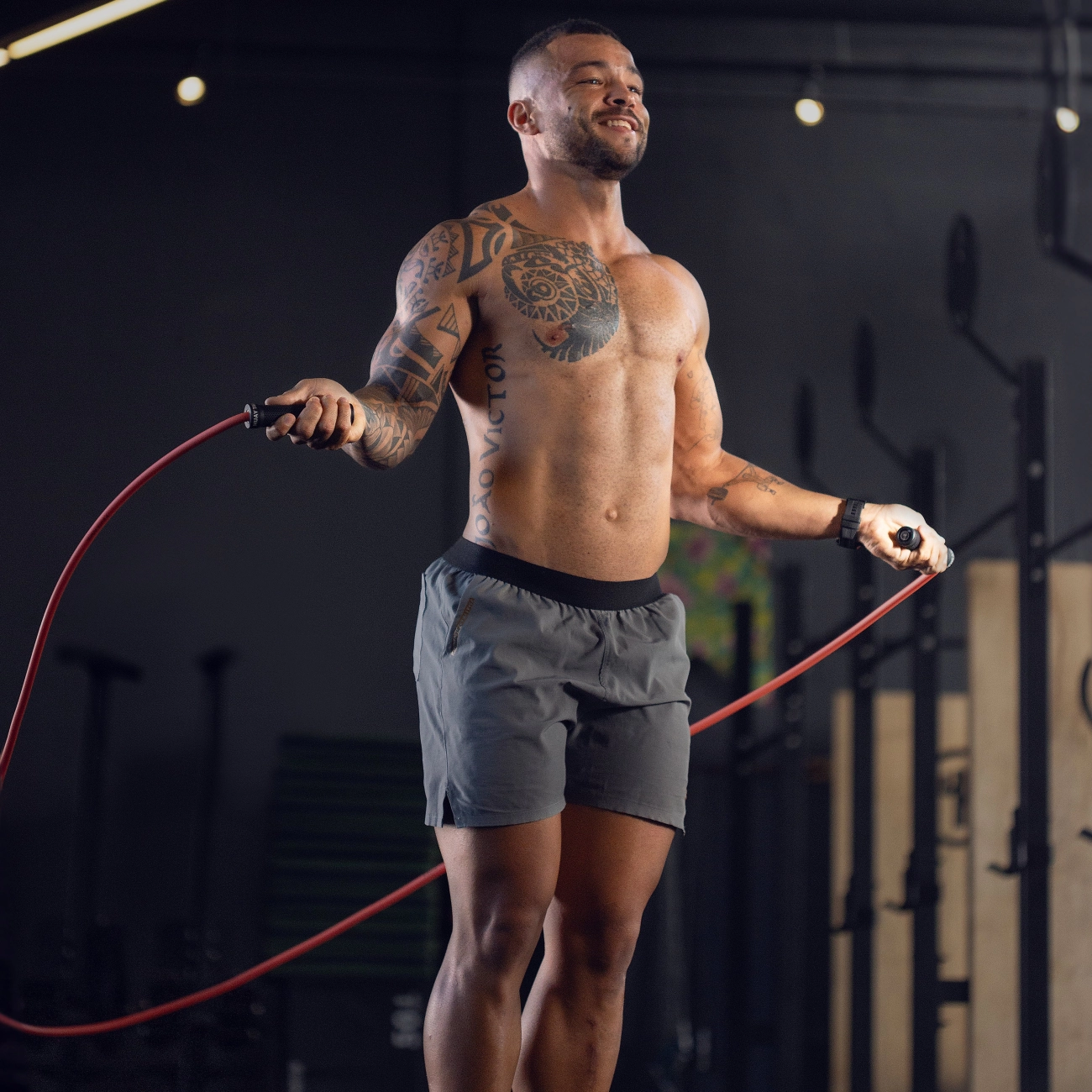Are you trying to decide between a weighted skipping rope and a speed rope for your workouts? Choosing the right jump rope can make a huge impact on your fitness results—whether you want to burn fat, build strength, or boost your agility.
At JumpRopeWholesale, we know every rope has its purpose. That’s why in this guide, we’ll break down the key differences between weighted skipping ropes and speed ropes. You’ll learn which one suits your personal goals, skill level, and workout style so you can jump rope smarter, not harder.
Ready to find out which jump rope fits your fitness journey the best? Let’s get started!
What Is a Weighted Skipping Rope
A weighted skipping rope is a jump rope designed with extra weight integrated either in the rope itself or the handles. Unlike traditional jump ropes, weighted ropes add resistance during your workout, making each jump more challenging. This resistance boosts muscle engagement, elevates calorie burn, and improves overall workout efficiency.
Materials and Design Characteristics
Weighted skipping ropes are typically made from durable materials like PVC or coated steel cables to support the added weight. The handles usually contain weighted cores, often using steel or iron beads, to create the necessary resistance. Some weighted ropes feature adjustable weights, allowing users to customize the intensity of their workout. The design focuses on durability and grip comfort to withstand the demands of resistance training.
Typical Weight Ranges
Weighted ropes generally vary in weight from 0.5 pounds to over 2 pounds depending on the intended use and fitness level. Beginner weighted ropes usually range between 0.5 and 1 pound, while more advanced users might opt for ropes weighing 1.5 to 2 pounds. The extra weight provides a slow, controlled rotation useful for strength and endurance building rather than speed.
Primary Fitness Goals Targeted
Weighted skipping ropes are primarily aimed at improving:
- Muscular strength and endurance by requiring more effort to swing and control the rope
- Increased calorie burn due to higher workout intensity created by the added resistance
- Enhanced cardiovascular fitness with sustained effort over time
- Improved coordination and joint stability through controlled and deliberate jumps
These ropes are an excellent choice for those who want to increase the physical challenge of skipping, support fat loss, and build functional strength.
For more on how jump ropes can maximize fat loss, see this does skipping rope burn fat guide.
What Is a Speed Rope

A speed rope is a specially designed skipping rope built for fast and efficient rotations. Unlike weighted ropes, speed ropes focus on lightweight materials and smooth mechanics to help you increase your jump speed and rhythm. This makes them ideal for workouts that require fast footwork and quick hand coordination.
Materials and Design Characteristics
Speed ropes typically feature:
- Lightweight cables made from thin steel wire coated with durable PVC or nylon. This combination keeps the rope fast and resistant to wear.
- Low-friction ball bearings in the handles that enable smooth and rapid rotation.
- Slim, ergonomic handles designed to provide a secure grip without adding unnecessary bulk or weight.
These materials allow the rope to spin quickly with minimal resistance, so you can maintain high tempo jumps for longer periods.
Features Enabling Fast Rotations
Key features making speed ropes quick and precise include:
- Ball bearing systems in the handles that reduce friction and allow continuous spinning.
- Flexible and lightweight cables that accelerate rotation with minimal effort.
- Adjustable lengths for customized fit, ensuring the rope doesn’t catch on the ground and interrupt speed.
- Slim handles that reduce drag and improve wrist movement efficiency.
Together, these features help improve your jumping speed with minimal strain.
Fitness Goals Targeted by Speed Ropes
Speed ropes are perfect for people aiming to enhance:
- Agility: Rapid rope speed improves quick foot movements useful in sports.
- Speed: Fast rotations train your ability to move quickly.
- Coordination: Synchronizing hand and foot movements develops better motor skills.
- Cardio endurance: High-intensity speed jumping burns calories fast and improves heart health.
For athletes, boxers, and fitness enthusiasts, speed ropes provide an excellent tool for high-intensity interval training (HIIT) and skill development. If you want a jump rope that helps with quick reflexes and fast-paced workouts, a speed rope should be your go-to choice.
Consider checking out our selection of professional speed ropes for boxing to elevate your training.
Key Differences Between Weighted Skipping Rope and Speed Rope
When deciding between a weighted skipping rope and a speed rope, understanding their key differences is essential to match your fitness goals and skill level.
Weight and Speed Heaviness vs Lightness
Weighted skipping ropes have heavier cords or handles, usually ranging from 1 to 3 pounds. This extra weight provides resistance, which helps build strength and burn more calories during workouts. However, the heaviness naturally slows down your rope speed and rotation.
On the other hand, speed ropes use very lightweight materials like PVC or thin wire cables. This makes them incredibly fast and easy to spin, ideal for quick, high-intensity workouts focusing on agility and speed.
Rope Speed and Rotation
The weighted rope rotates slower due to its mass, making it perfect for controlled, strength-focused exercises. They demand more effort per jump, increasing workout intensity through resistance.
Conversely, speed ropes spin rapidly with minimal effort, enabling fast footwork and quick rope turns. This feature is why speed ropes are the go-to choice in professional speed rope workouts and boxing training.
Skill Level Required
If you’re new to jumping rope, a weighted skipping rope can be more forgiving because the slower rotations let you master timing and coordination without rushing.
Speed ropes require a higher skill level due to their fast rotations. Beginners often find speed ropes challenging until they develop better rhythm and agility.
Impact on Workout Intensity
Both types ramp up workout intensity—but in different ways:
- Weighted ropes increase muscular endurance and strength, adding resistance that challenges your upper body and core more.
- Speed ropes elevate heart rate fast, making them perfect for cardio-heavy sessions and high-intensity interval training (HIIT).
Choosing between the two depends on whether you want to focus on resistance training or cardio conditioning.
Portability and Ease of Use
When it comes to portability, speed ropes are usually more compact and lightweight, making them convenient for workouts on the go. They often feature adjustable lengths and easy-to-carry designs.
Weighted ropes tend to be bulkier due to their heavy cords and handles. While still portable, they might not be as travel-friendly or quick to pack.
By understanding these differences in weight, speed, skill requirement, intensity impact, and portability, you can better decide which jump rope suits your fitness routine—whether strength training with a weighted rope or enhancing speed and agility with a speed rope.
Benefits of Using a Weighted Skipping Rope
Using a weighted skipping rope offers several advantages that go beyond basic cardio. If you’re looking to add resistance to your workouts, this rope type is a smart choice. Here’s why:
Build Muscular Strength and Endurance
Unlike lighter ropes, weighted jump ropes help strengthen your upper body muscles—especially your shoulders, arms, and forearms. The extra weight forces your muscles to work harder with every swing, making it great for building muscular endurance over time. This added resistance also helps improve your grip strength, which is often overlooked in other skipping workouts.
Increase Calorie Burn
Heavier ropes require more effort to turn, meaning your body burns more calories per minute than with a standard or speed rope. If fat loss or burning calories fast is your goal, weighted ropes push your metabolism harder. This makes them an effective tool for those who want to maximize their fat loss workouts with skipping.
Improve Coordination and Bone Density
Using a weighted rope is not just strength-building; it challenges your timing and rhythm, which enhances your hand-eye coordination and overall body control. The impact of landing and the rope’s resistance also stimulate bone density, making weighted skipping a good choice for improving joint health and reducing injury risk over time.
Suitability for Resistance-Based Workouts
Weighted skipping ropes fit perfectly into resistance training routines. They add intensity without needing heavy equipment and can complement weightlifting or bodyweight exercises. This makes them an excellent option for people wanting both strength and cardio benefits in a single workout.
In short: weighted skipping ropes help you build strength, burn more calories, and improve coordination, making them an ideal tool for resistance-focused fitness and fat loss goals.
Benefits of Using a Speed Rope for Cardio and Agility
A speed rope is designed to help you move fast and stay light on your feet. Here’s why it stands out when it comes to workouts focused on speed, agility, and coordination.
High Intensity Interval Training and Cardio Focus
One of the biggest benefits of a speed rope is its effectiveness for high intensity interval training (HIIT). The lightweight design and fast rotation allow you to maintain rapid jumping speeds, which boosts your heart rate quickly and keeps it up. This makes speed ropes perfect for:
- Burning calories efficiently
- Improving cardiovascular endurance
- Supporting weight loss and fat burning goals
Improving Foot Speed and Agility
The fast pace of speed rope workouts helps train your legs to move quicker and more precisely. This is key for enhancing foot speed and agility, which benefits:
- Runners aiming to increase stride turnover
- Athletes needing sharp directional changes
- Anyone wanting improved balance and quick reflexes
Enhancing Hand Eye Coordination
Using a speed rope requires tight coordination between your hands and eyes to time each jump perfectly. This trains your brain and muscles to work smoothly together, improving overall hand-eye coordination. This skill carries over well into many sports and daily activities where timing and rhythm matter.
Effective for Professional Athletes and Boxers
Speed ropes are the go-to choice for many pro athletes, especially boxers. Their ability to rotate quickly helps athletes:
- Develop rapid footwork and endurance
- Sharpen reflexes in the ring or on the field
- Build stamina without extra bulk or strain
The lightweight, low-resistance design makes speed ropes ideal for extended high-speed sessions while reducing fatigue.
a speed rope is your best bet if your goals focus on fast-paced cardio, improving agility, and developing coordination. It’s a must-have for anyone looking to push their workout intensity without adding weight or slowing down.
Which Rope Is Best for Your Fitness Goals

Choosing between a weighted skipping rope and a speed rope depends largely on what you want to achieve with your workouts. Each type targets different fitness goals, so let’s break it down based on common priorities.
Weight Loss and Fat Burning
If your primary goal is weight loss and burning calories, both ropes can help, but in different ways:
- Weighted skipping ropes add resistance, making each jump more challenging. This leads to higher calorie burn because you engage more muscles. They’re great for fat loss because of the increased workout intensity.
- Speed ropes allow for rapid, continuous jumps, perfect for cardio training and high-intensity interval workouts. Faster rope rotations elevate your heart rate quickly, which is excellent for shedding pounds.
Bottom line: Use weighted ropes for longer, strength-based sessions, and speed ropes for fast-paced cardio bursts to maximize fat burning.
Building Muscle vs Improving Speed
- Weighted jump ropes are your go-to if you want to build muscle strength and endurance. The added weight works your arms, shoulders, and core more intensely. It’s a simple way to incorporate resistance training into your routine.
- On the other hand, speed ropes are designed for boosting agility, quickness, and coordination. They help improve your footwork and hand-eye coordination, which is crucial for athletes and boxers focused on speed and precision.
Beginners vs Advanced Jumpers
- For those just starting out, a weighted skipping rope might feel easier because the slower rotation gives more time to learn proper form and timing. It builds strength while keeping the pace manageable.
- Speed ropes require more skill and rhythm. If you’re new to jumping rope, you might struggle to control fast rotations initially. Advanced jumpers benefit most from speed ropes to push their limits and enhance performance.
Cross Training and Sport Specific Uses
- If you’re into cross training or sports like boxing, MMA, or track where quick footwork is essential, a speed rope fits best. It trains speed and coordination necessary for those sports.
- For sports or workout routines incorporating resistance and strength training, a weighted jump rope adds value by improving muscle endurance and overall power. It’s also excellent for bone density and injury prevention.
- Choose weighted skipping ropes for fat loss, muscle building, endurance, and beginner-friendly workouts.
- Opt for speed ropes to improve speed, agility, cardio, and sport-specific skills, especially if you’re more advanced.
Having both in your routine can be a great combo—using weighted ropes for strength days and speed ropes for cardio and skill development to cover all your fitness bases.
How to Choose the Right Jump Rope for You

Picking the right jump rope is key to getting the most out of your workouts, whether you’re after fat loss, speed, or strength. Here’s how to find the best fit based on your fitness level, goals, and preferences.
Consider Your Fitness Level and Goals
- Beginners will want a rope that’s easy to control—usually a lighter speed rope with comfortable handles.
- If your focus is building muscle and endurance, a weighted skipping rope is better suited.
- For cardio training, agility, and speed, a speed rope designed for fast rotations will serve you well.
- Think about whether your goal is fat loss, coordination, or sport-specific training like boxing or HIIT workouts.
Pick the Right Rope Length and Handle Comfort
- Rope length matters: Too long or too short throws off your rhythm. Stand on the middle of the rope—handles should reach roughly to your armpits.
- Handle comfort and grip are crucial to avoid hand fatigue and blisters during extended workouts.
- Look for handles with non-slip grips and a good balance to control rope rotation smoothly.
Evaluate Rope Materials and Customization Options
- Weighted ropes often feature thicker PVC or steel cables with added coatings for durability and resistance.
- Speed ropes rely on lightweight materials like thin PVC or braided cables with ball-bearing handles for fast, smooth spins.
- Check if the rope is adjustable—this helps customize the length for your height and style.
- Consider ropes with customizable handles or interchangeable parts if you want to adapt your rope over time.
Combine Weighted and Speed Ropes for Balanced Training
- Use a weighted rope for strength, endurance, and calorie burn sessions.
- Switch to a speed rope when working on quick footwork, agility, and high-intensity intervals.
- Combining both ropes maximizes your skip rope workouts by targeting different muscle groups and skills, perfect for effective cross-training.
By keeping these points in mind, you’ll select a jump rope tailored to your needs—helping you stay motivated and get better results every time you jump.
How to Properly Use and Maintain Your Jump Rope
Using your weighted skipping rope or speed rope correctly and taking good care of it will maximize your workout results and extend the lifespan of your gear. Here’s what you need to know.
Basic Jumping Techniques for Weighted and Speed Ropes
Weighted Skipping Rope
- Use a controlled pace with smooth wrist rotations—this helps manage the rope’s heavier weight.
- Focus on landing softly on the balls of your feet to reduce joint impact.
- Keep your elbows close to your sides to maintain consistent rope rotation.
- Great for steady, strength-focused workouts, so pace yourself without rushing the rope speed.
Speed Rope
- Use quick wrist flicks and minimal arm movement to achieve fast rotations.
- Stay on your toes, bouncing lightly for agility and speed.
- Keep your jumps low and compact to maintain rhythm and avoid tripping.
- Perfect for high-intensity cardio routines, so work on increasing speed and foot coordination.
Safety Tips When Jumping
- Warm up before jumping to prepare your muscles and reduce injury risk.
- Use a flat, shock-absorbing surface like gym mats or wood floors, rather than concrete.
- Wear supportive, cushioned shoes with good grip.
- Start slow and gradually increase your jump duration and speed.
- If you’re new to weighted ropes, begin with short sessions to avoid overstraining wrists and shoulders.
Cleaning and Storage to Prolong Rope Life
- Wipe down your rope handles and length with a damp cloth after workouts to remove sweat and dirt.
- Avoid submerging the rope in water unless specified by the manufacturer.
- Keep your rope coiled loosely without kinks or tight knots to prevent damage and tangling.
- Store your jump rope in a cool, dry area, away from direct sunlight or extreme temperatures.
- Check your rope regularly for wear, especially around the handles and bearings, to ensure smooth use and safety.
By following these basic techniques and care steps, you’ll get the most out of both weighted and speed skipping ropes while keeping them in great shape for your fitness journey.
For a reliable rope with options suited for both styles, check out our selection of rubber skipping ropes and ball bearing skipping ropes.
Why Choose JumpRopeWholesale for Your Weighted Skipping Rope and Speed Rope Needs
When it comes to finding the right skipping rope, JumpRopeWholesale stands out as a top choice for both weighted skipping ropes and speed ropes. As a trusted manufacturer and supplier based in the US, we offer a wide selection designed to suit all fitness levels and workout goals.
Extensive Range of Weighted and Speed Ropes
Our product range includes everything from heavier weighted jump ropes ideal for strength and endurance workouts, to lightweight speed ropes perfect for fast-paced cardio and agility training. Whether you want to build muscle, burn fat, or improve foot speed, we have ropes built to match those goals.
Customization and Wholesale Ordering Made Easy
We understand that individual preferences matter. That’s why we offer customize skipping rope options allowing you to pick handle styles, rope lengths, and materials that work best for your routine. If you’re buying for a gym, team, or bulk order, our wholesale ordering process is straightforward and tailored to help you get the best value.
Quality You Can Count On and Dedicated Support
Every rope we produce meets strict quality standards to ensure durability and smooth performance. Our commitment to quality means your skipping rope will last through intensive use, helping you stay consistent with your workouts. Plus, our customer support team is ready to assist with questions and guidance so you can pick the perfect rope confidently.
Browse Our Product Catalog Today
Ready to take your fitness routine to the next level? Explore our selection of weighted skipping ropes, speed ropes, and more by visiting our online catalog. Check out popular products like the boxing skipping rope or browse options with digital counters for tracking your progress. See what fits your style and fitness needs, then place your order hassle-free.
For additional info on product features and FAQs, visit our jump rope FAQs page. If you’re ready to shop now, head over to the cart and secure your skipping rope today.
With JumpRopeWholesale, you get quality, variety, and expert support all in one place — perfect for anyone serious about their skipping rope workouts.



